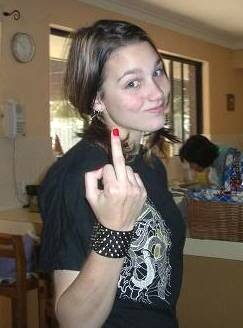
"Sisters, sisters
There were never such devoted sisters,
Never had to have a chaperone, no sir,
I'm there to keep my eye on her. . . "
While her half-sister sat on the throne of England and Ireland (France? Not so much, lol Calais) from 1553 - 1558, Elizabeth so wished her half-sister, Mary, kept less of an eye on her.
Much, much less of an eye on her.
The eyes Mary had on Elizabeth were not just her own - Mary had many eyes on Elizabeth.
 |
| Wrong century, right idea. |
 | |
| "Isn't it bad enough you're making me go to church all the time and carry a Rosary?" |
Princess Mary, daughter to Catherine of Aragon and Henry VIII got to ripe old age of seventeen when the rug of her royal life was pulled rudely out from under her.

Her father 'distanced' both Mary and her mother from court; Catherine of Aragon was shifted from one uncomfortable moldy old palace/manor house/hall to another even more uncomfortable palace/manor house/hall - and frequently.
In Tudor England, monarchs believed in letting Nature take her course with people they now found 'inconvenient' or 'a threat' - chilly, damp, mildew and moldy lodgings out where Jesus lost his sandals did a fair job of grinding down the inconvenient or threatening person.
Toss in not-at-all generous portions of lousy food, seclusion, and denial of visits from children/family, then replace trusted servants with unfriendly spies and thick blankets with thin, cut back on the firewood and - voila!
Inconvenient people dropped like flies; victims of neglect and genteel starvation.
Mary lived through some of the neglect, but even worse was having seen her mother, England's queen, tossed away so her father, the king, could take up with a dark-haired creature, fresh from France, named Anne Boleyn.
Life for Mary went from bad to worse; the more she and her mother insisted they were the rightful queen and princess of England, the more privileges that got yanked.
Both Catherine and Mary were stubborn as hell in a "I keep shooting myself in the foot, but I will NOT give up" kind of way.
Such tenacity; when Henry VIII hauled Catherine into court over their divorce, Catherine dissed the court in every possible way.
She walked in late, got down on her knees in front of Henry and begged him to do the the right thing by her.
Henry was horribly mortified - he'd expected Mary's mother to simply cave and give in.
After Catherine had her say in court, she walked toward the door, and when told she did NOT have permission to leave, she told them all there was no justice in the room for her, so "F.O.A.D. to all of you."
Mary displayed a lot of the same type of fire when she was crossed.
When Catherine of Aragon died of neglect, a broken heart, and what was likely a type of cancer, it was January of 1535.
Mary was nineteen.
Downgraded from Princess Mary to Lady Mary, bastard daughter of the king, and adding insult to injury, she shared her household with Anne Boleyn's daughter, Elizabeth.
Her sister.
And Anne Boleyn?
 | |
| "You must bow to me!" - to which Mary replied: |
 |
| "Bow THIS, Anne Boleyn." |
In spite of having every reason to despise her half-sister, Mary seemed unable to bring herself to hate the baby girl.
Either Elizabeth was an awfully engaging baby, or Mary didn't have it in her to hate the innocent little one, or more likely, it was a combination of both.
Their sisterhood was cemented during Elizabeth's infancy and Mary, regardless of how her attitude toward her half-sister changed over the years, walked her talk when it came to blood ties and keeping to her word.
After Henry VIII disposed of Elizabeth's mother,
 |
| "LOL!! I can still see you, Mr. Swordsman!" |
both his daughters were motherless - another similarity shared between them - and when their father married Jane Seymour, a little bit of 'fun' surfaced in the 'dysfunction' of their family.
Jane not only gave Henry VIII a boy (and thank God for that, the king very much needed to relax his crack on that topic) but also influenced Henry VIII to lighten up on Mary.
Once Mary was
Meanwhile, Mary stood godmother to Jane and Henry's son, Prince Edward, while little Elizabeth also participated in his very elaborate christening at Hampton Court Palace.
 |
| That's one heck of a long train on that christening gown. No expense spared! |
Jane Seymour fell victim to post childbirth complications and died within days of delivering little Prince Edward, and with her death, Mary lost one of the few people in the world who, since 1535, had ever showed her any kindness at all.
Think about how that would feel; dead mother, father married to trophy wife who made a point of making Mary feel like subservient shit most of the time, father has trophy wife's head cut off
 |
| 'Holy shit, I know I prayed for that, but I never expected it to actually happen!" |
That's a lot of family transitioning.
Fortunately for Mary and Elizabeth, their father's next wife was pragmatic and kind; Anne of Cleves was Wife #4.
Anne of Cleves and Henry VIII didn't meet until a few days before their wedding.
Henry VIII did NOT care for her; Anne of Cleves had a major clutch moment, imagining an Anne Boleyn-type of ending - and that fear no doubt drove her to agree to a divorce.
Her pragmatism and kindness stood her in good favor with the king; he was delighted that she caved so completely in agreeing to a divorce and rewarded her good sense with a generous income and several places to call home.
Henry VIII moved on to a short and disastrous marriage to the very young, very dishy, very round-ankled Catherine Howard.

Mary was kindergarten-aged by the time Catherine Howard was born.
Really, Dad?
She had to be younger than me?
When Catherine Howard's infidelities, both before and during her marriage to the king came out, blinking, into the bright light of day, Henry VIII was crushed, hurt and then angry.
Very angry.
Catherine Howard got the chop but not before leaving behind a visage of herself on auto-repeat, running screaming down a Gallery at Hampton Court Palace - totally true, if you believe that sort of thing.
You can look it up.
Henry VIII, shattered at the sudden loss of the pretty, flirty, sweet young thing who'd let him stick his hand up her skirt whenever he wanted, stayed down in the dumps for months.
Then he got married for the last time, to the very decent and smart Catherine Parr.
Henry was often out-of-sorts; chronic pain issues and other complaints that came from eating a meat-based diet; also the aches and pains of a grossly obese elderly man.
Catherine was was the wife who ushered the old rascal out of this life on 28 January, 1547.
She was the wife who outlived Henry VIII.

Nine year old Prince Edward became nine year old Edward VI.
He was a smart kid, very academic and very sure his realm was a Protestant realm.
Mary, raised in 'the old (pre-Anne Boleyn) Catholic faith' disagreed most heartily.
She'd always been an observant Catholic but not remarkably so; but all of a sudden she made it her business to get awfully vocal about religion.
Mary sounded off on Edward's age as too young to make decisions of any kind.
And by decisions, she meant religion.
She simply would not shut up about it.

Edward VI argued with her constantly: her disregard for laws in his kingdom led to at least one ruined family holiday.
One Christmas, their differences on religion led to screaming, led to tears (his) and more tears (hers,) and more screaming.
Edward VI had to accept that agree with her or not, Mary said what she meant, and she meant what she said.
And that strength of conviction was her legacy, although it gets a negative spin if it's mentioned at all - but I believe her personal integrity is what ultimately saved Elizabeth during the Wyatt rebellion's fallout.
Mary promised Elizabeth at some point that Elizabeth would never be punished as a traitor without proof.
Mary was a woman whose word was her deed.
After Edward VI died young (15) of a lung ailment, he'd left instructions for his Protestant cousin, Lady Jane Grey, to succeed him.
Mary's answer to that was a very clear, "As if!"
She rode into London with an army of her supporters - the woman was fearless.
If the people wanted Lady Jane Grey as queen, Mary would be putting her life on the line.
Mary was in a 'go big, or go home' mood, though - and Parliament bought her claim to the throne.
She flicked her cousin, Lady Jane Grey, into the Tower.
Eventually, she had to have her executed, but it was not Mary's wish - until she had to make a stand for her throne.
Then she signed her cousin's death warrant.
But that left Mary with a terrible idea - what she'd done to Lady Jane Grey, her sister might do to her.
That was when Mary really kept her eye(s) on Elizabeth.
Mary's spies were always around; listening to what Elizabeth said, reading her correspondence, reporting if Elizabeth did, or did not, observe the Catholic Mass as she'd promised Mary she would.
When Thomas Wyatt the Younger brought a fight to Mary, one aimed at replacing her with Elizabeth, Mary finally went ham on her half-sister.
With orders to round her up and bring her to face the queen, Mary was livid when Elizabeth shilly-shallied and wrote a l-o-n-g letter to Mary, reminding Mary that she'd once given her a promise that she'd never punish without proof.
Mary kept her word.
Mary did not have a long life; she died just forty-two years old.
She'd made her own devise for succession for the throne of England after her death.
She named her half-sister, whose Tudor red-gold hair was just like their father's Tudor red-gold hair; the best imaginable visual reminder to the people of England of the continuity of the Tudor bloodline
Keeping England Catholic was less important to Mary than keeping England's crown in her father's bloodline.
All the humiliations thrown at her when her father ditched her mother and married Anne Boleyn still counted - but Mary's actions reflected her words.
Elizabeth's life depended on that - and Mary did not go back on her word.
Sisters.

No comments:
Post a Comment